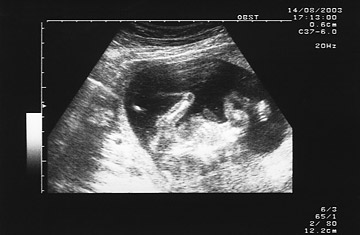
An ultrasound scan is taken before an amniocentesis procedure is performed.
"Doctors make the worst patients," the obstetrician told my wife and me as we waited anxiously for the results of an ultrasound on our second baby, due any day. He was only half joking. All along, I'd been asking him a lot of questions—as I tend to do when I'm nervous—about something called first-trimester prenatal screening. When our first child was born, almost two years earlier, this test for Down syndrome and other birth defects was still brand new. Wary and unsure about its value and accuracy, we decided to pass. This time around, however, we had done our homework, which was slightly frustrating for our doctor.
The first thing we learned was that in the two years since the birth of our first child, the new test had become part of standard medical practice. In fact, on Jan. 2 the American College of Obstetricians and Gynecologists recommended that all pregnant women get the test regardless of age. This is an important change, mostly because of what it means for amniocentesis.
Amniocentesis, as every mom-to-be of a certain age can tell you, is a medical procedure in which a doctor inserts a long needle through the belly and into the placenta to withdraw amniotic fluid—which is then screened for birth defects. It used to be that once a woman turned 35, she was always counseled about amniocentesis. The cutoff at 35 was, by just about everyone's admission, pretty arbitrary; it was the age at which the risk of Down syndrome seemed to increase. For example, the risk of Down for a 25-year-old woman is about 1 in 1,250. By age 40, that risk has jumped to 1 in 100. What makes the decision so difficult for many parents is that the test carries a slight but real risk of miscarriage.
The new test, by contrast, is noninvasive. It combines two routine blood tests and an ultrasound that measures something called nuchal translucency, a property of the fluid at the back of the baby's neck that tells doctors with better than 90% accuracy whether the baby is at increased risk of Down syndrome. If the test is positive, you still have to decide whether to undergo amniocentesis or another test, chorionic villus sampling, to confirm the diagnosis one way or the other. But if it's negative, you're out of the woods.
Almost. As we were sitting there in the office, we realized we still faced an enormously difficult decision. Whenever you have a medical test, you have to ask yourself, What am I going to do with this new information? Some parents will choose to terminate a pregnancy if a diagnosis of Down is confirmed. Some will start putting dollars into tax-free health-savings accounts to help defray the cost of caring for a child with Down. Others may change the hospital where they plan on having the baby, opting instead for an institution that specializes in high-risk pregnancies. Even parents who would never consider termination may still want to be more emotionally prepared. The hardest part, we are told, is waiting for results, which can take several long days.
So from now on, all pregnant women in the U.S. will be offered a choice of tests. My advice, as a doctor who has wrestled with the decision, is that if you choose the relatively new ultrasound test, you should also choose a hospital where the technicians have been trained to perform it. That can have a big effect on the trustworthiness of the results. As for my wife and me, we opted for the minimalist approach. We don't even know the sex of the child. We are hoping for a boy ... or a girl